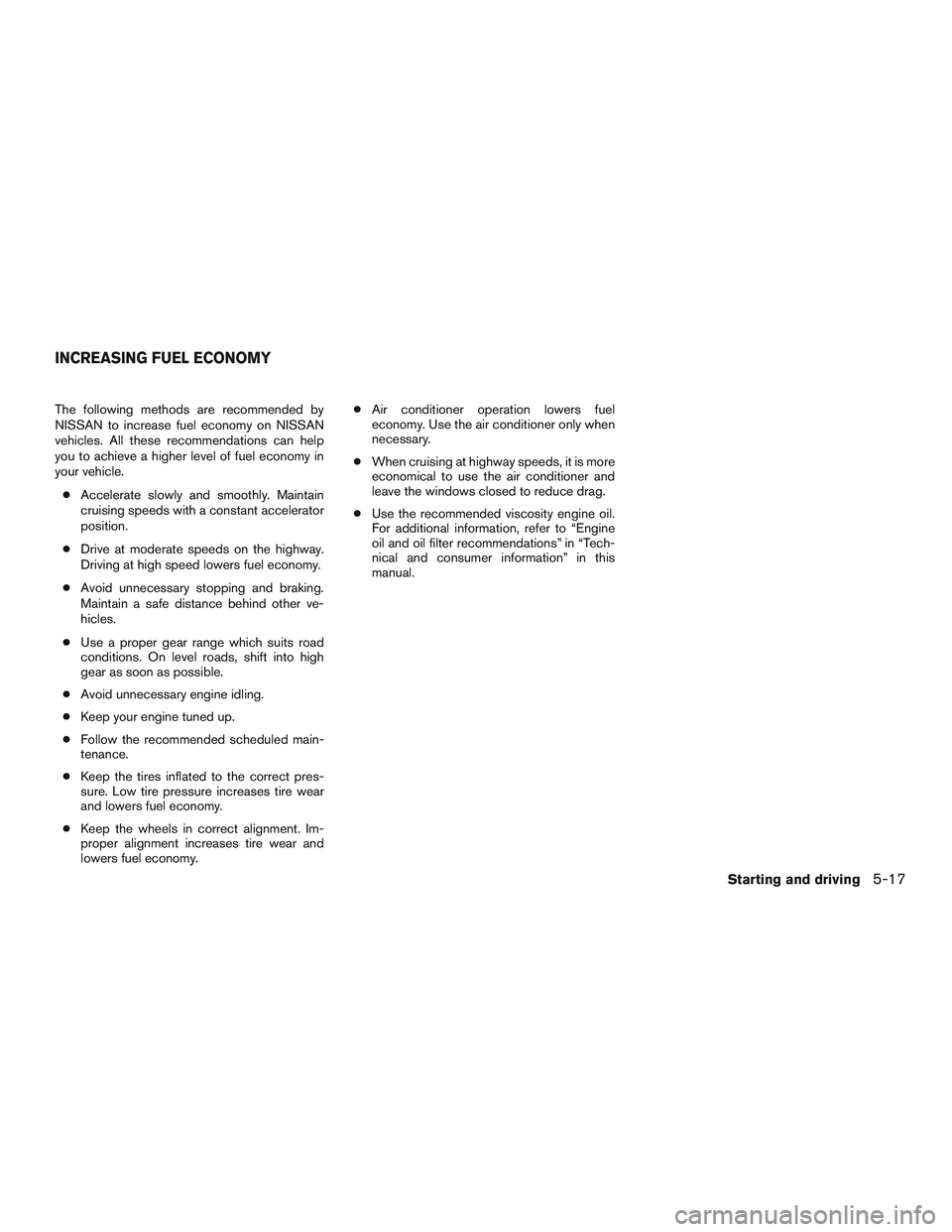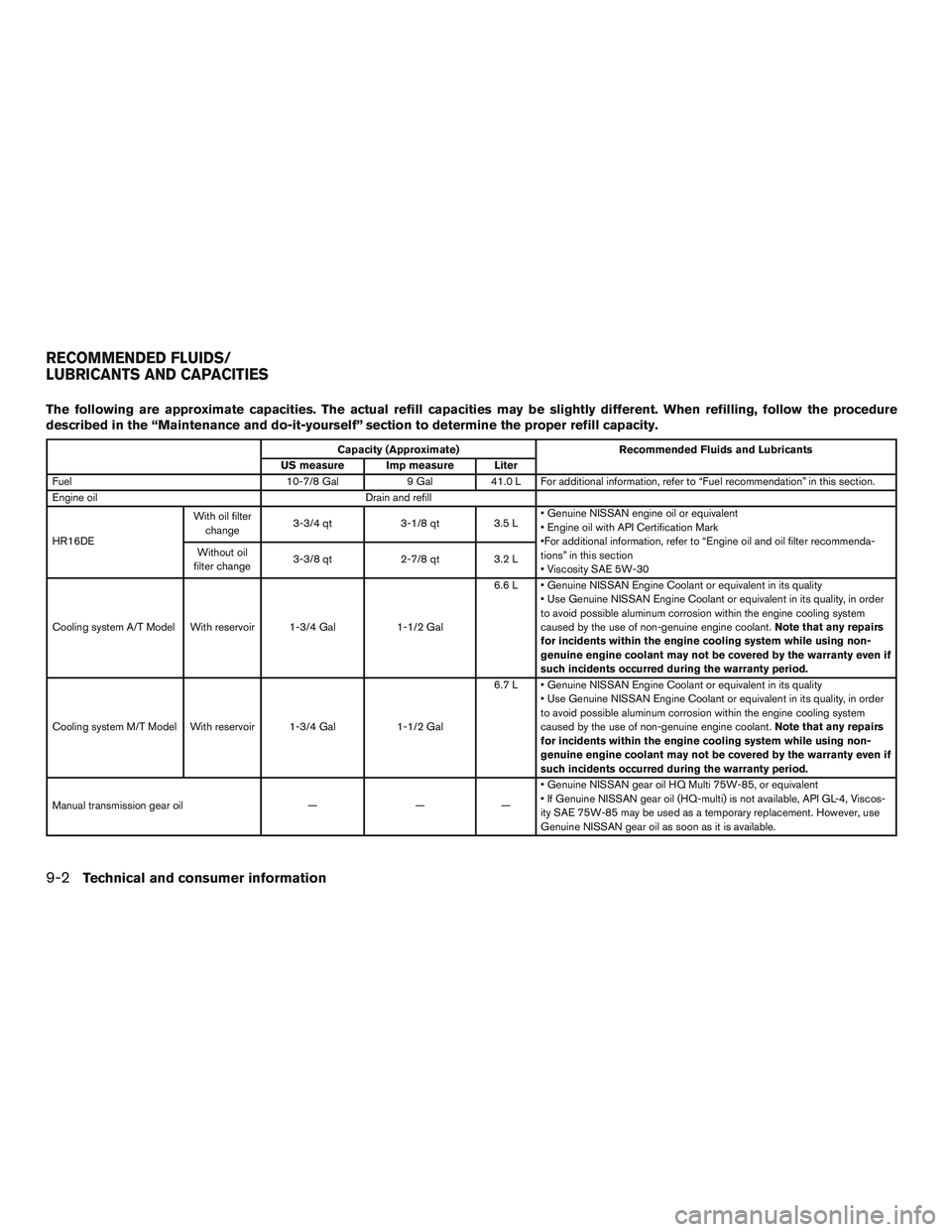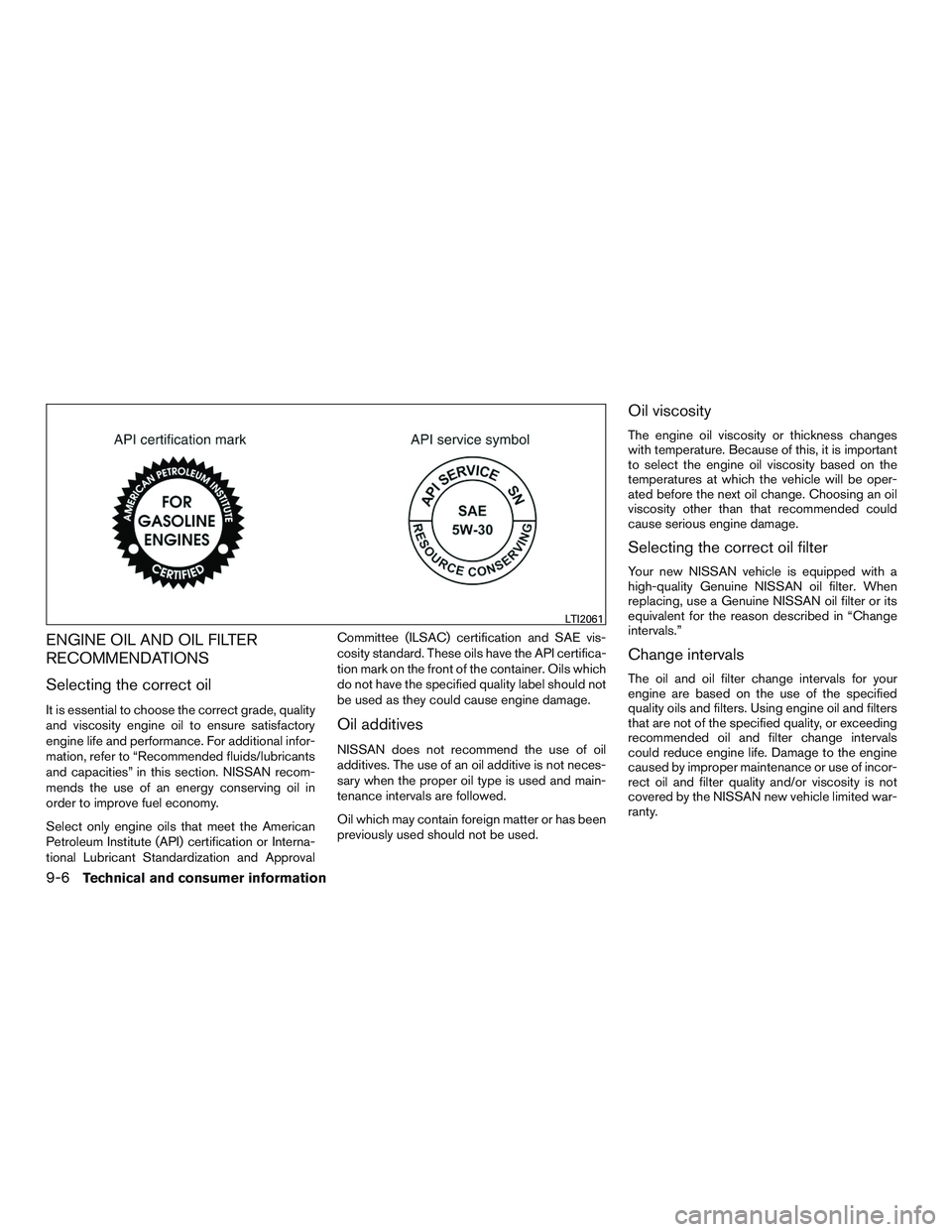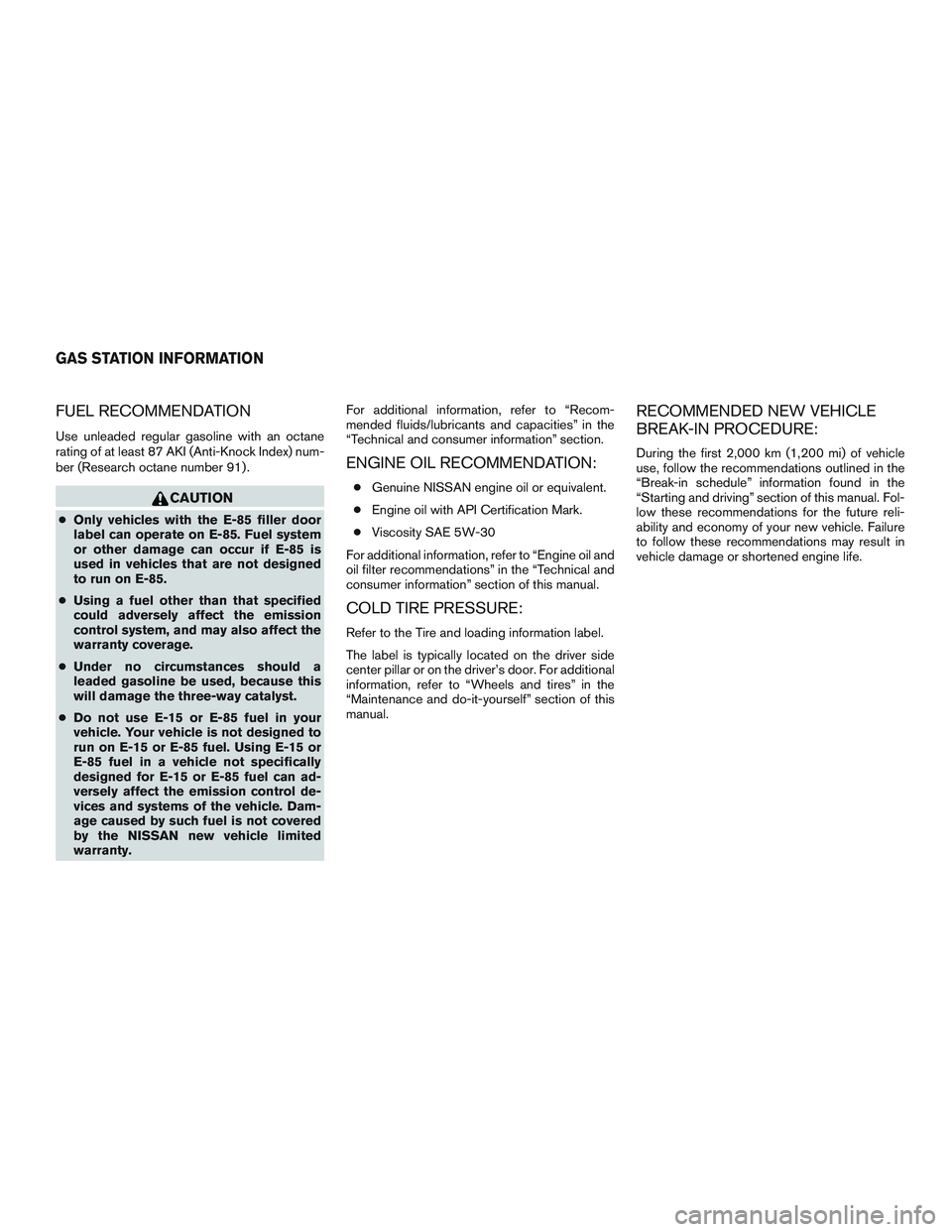2015 NISSAN MICRA oil viscosity
[x] Cancel search: oil viscosityPage 190 of 293

The following methods are recommended by
NISSAN to increase fuel economy on NISSAN
vehicles. All these recommendations can help
you to achieve a higher level of fuel economy in
your vehicle.● Accelerate slowly and smoothly. Maintain
cruising speeds with a constant accelerator
position.
● Drive at moderate speeds on the highway.
Driving at high speed lowers fuel economy.
● Avoid unnecessary stopping and braking.
Maintain a safe distance behind other ve-
hicles.
● Use a proper gear range which suits road
conditions. On level roads, shift into high
gear as soon as possible.
● Avoid unnecessary engine idling.
● Keep your engine tuned up.
● Follow the recommended scheduled main-
tenance.
● Keep the tires inflated to the correct pres-
sure. Low tire pressure increases tire wear
and lowers fuel economy.
● Keep the wheels in correct alignment. Im-
proper alignment increases tire wear and
lowers fuel economy. ●
Air conditioner operation lowers fuel
economy. Use the air conditioner only when
necessary.
● When cruising at highway speeds, it is more
economical to use the air conditioner and
leave the windows closed to reduce drag.
● Use the recommended viscosity engine oil.
For additional information, refer to “Engine
oil and oil filter recommendations” in “Tech-
nical and consumer information” in this
manual.
INCREASING FUEL ECONOMY
Starting and driving5-17
Page 267 of 293

The following are approximate capacities. The actual refill capacities may be slightly different. When refilling, follow the procedure
described in the “Maintenance and do-it-yourself” section to determine the proper refill capacity.
Capacity (Approximate)Recommended Fluids and Lubricants
US measure Imp measure Liter
Fuel 10-7/8 Gal9 Gal41.0 L For additional information, refer to “Fuel recommendation” in this section.
Engine oil Drain and refill
HR16DE With oil filter
change 3-3/4 qt
3-1/8 qt3.5 L• Genuine NISSAN engine oil or equivalent
• Engine oil with API Certification Mark
•For additional information, refer to “Engine oil and oil filter recommenda-
tions” in this section
• Viscosity SAE 5W-30
Without oil
filter change 3-3/8 qt
2-7/8 qt3.2 L
Cooling system A/T Model With reservoir 1-3/4 Gal 1-1/2 Gal6.6 L • Genuine NISSAN Engine Coolant or equivalent in its quality
• Use Genuine NISSAN Engine Coolant or equivalent in its quality, in order
to avoid possible aluminum corrosion within the engine cooling system
caused by the use of non-genuine engine coolant. Note that any repairs
for incidents within the engine cooling system while using non-
genuine engine coolant may not be covered by the warranty even if
such incidents occurred during the warranty period.
Cooling system M/T Model With reservoir 1-3/4 Gal 1-1/2 Gal6.7 L • Genuine NISSAN Engine Coolant or equivalent in its quality
• Use Genuine NISSAN Engine Coolant or equivalent in its quality, in order
to avoid possible aluminum corrosion within the engine cooling system
caused by the use of non-genuine engine coolant. Note that any repairs
for incidents within the engine cooling system while using non-
genuine engine coolant may not be covered by the warranty even if
such incidents occurred during the warranty period.
Manual transmission gear oil ———• Genuine NISSAN gear oil HQ Multi 75W-85, or equivalent
• If Genuine NISSAN gear oil (HQ-multi) is not available, API GL-4, Viscos-
ity SAE 75W-85 may be used as a temporary replacement. However, use
Genuine NISSAN gear oil as soon as it is available.
RECOMMENDED FLUIDS/
LUBRICANTS AND CAPACITIES
9-2Technical and consumer information
Page 271 of 293

ENGINE OIL AND OIL FILTER
RECOMMENDATIONS
Selecting the correct oil
It is essential to choose the correct grade, quality
and viscosity engine oil to ensure satisfactory
engine life and performance. For additional infor-
mation, refer to “Recommended fluids/lubricants
and capacities” in this section. NISSAN recom-
mends the use of an energy conserving oil in
order to improve fuel economy.
Select only engine oils that meet the American
Petroleum Institute (API) certification or Interna-
tional Lubricant Standardization and ApprovalCommittee (ILSAC) certification and SAE vis-
cosity standard. These oils have the API certifica-
tion mark on the front of the container. Oils which
do not have the specified quality label should not
be used as they could cause engine damage.Oil additives
NISSAN does not recommend the use of oil
additives. The use of an oil additive is not neces-
sary when the proper oil type is used and main-
tenance intervals are followed.
Oil which may contain foreign matter or has been
previously used should not be used.
Oil viscosity
The engine oil viscosity or thickness changes
with temperature. Because of this, it is important
to select the engine oil viscosity based on the
temperatures at which the vehicle will be oper-
ated before the next oil change. Choosing an oil
viscosity other than that recommended could
cause serious engine damage.
Selecting the correct oil filter
Your new NISSAN vehicle is equipped with a
high-quality Genuine NISSAN oil filter. When
replacing, use a Genuine NISSAN oil filter or its
equivalent for the reason described in “Change
intervals.”
Change intervals
The oil and oil filter change intervals for your
engine are based on the use of the specified
quality oils and filters. Using engine oil and filters
that are not of the specified quality, or exceeding
recommended oil and filter change intervals
could reduce engine life. Damage to the engine
caused by improper maintenance or use of incor-
rect oil and filter quality and/or viscosity is not
covered by the NISSAN new vehicle limited war-
ranty.
LTI2061
9-6Technical and consumer information
Page 287 of 293

Child restraints.......1-16,1-17,1-18,1-20
LATCH (Lower Anchors and Tethers for
CHildren) System ..............1-20
Precautions on child
restraints.........1-18,1-25,1-31,1-36
Top tether strap anchor point locations . .1-22
Child safety rear door lock ............3-5
Chimes, audible reminders ...........2-12
Cleaningexteriorandinterior...........7-2
Clock.......................4-33 (models without navigation system) ....4-33
Clockset.....................4-33
Clock set/adjustment ..............4-33
Clutch Clutch fluid ..................8-12
C.M.V.S.S. certification label ..........9-11
Cold weather driving ...............5-24
Compact disc (CD) player ........4-34,4-38
Controls Audiocontrols(steeringwheel).......4-44
Heater and air conditioner controls . .4-7, 4-15
Coolant Capacities and recommended
fuel/lubricants .................9-2
Changing engine coolant ...........8-8
Checking engine coolant level ........8-8
Corrosionprotection ...............7-5
Cruisecontrol..................5-15
Cupholders................2-22,2-23
Curtain side-impact air bag system
(See supplemental side air bag and curtain
side-impact air bag system) ...........1-52 D
Daytime light system ...............2-18
Defroster switch Rear window defroster switch .......2-16
Dimensionsandweights.............9-9
Dimmer switch for instrument panel ......2-18
Door locks .....................3-3
Door open warning light .............2-8
Drive belt .....................8-15
Driving Cold weather driving .............5-24
Driving with automatic transmission .....5-8
Driving with manual transmission ......5-12
Precautions when starting and driving ....5-2
Driving the vehicle .................5-8
E
Economy - fuel ..................5-17
Emission control information label .......9-11
Emission control system warranty .......9-18
Engine Before starting the engine ..........5-7
Block heater .................5-25
Capacities and recommended
fuel/lubricants .................9-2
Changingenginecoolant...........8-8
Changingengineoil.............8-10
Changing engine oil filter ..........8-11
Checking engine coolant level ........8-8
Checking engine oil level ...........8-9
Engine compartment check locations ....8-6
Engine cooling system ............8-7 Engineoil ...................8-9
Engine oil and oil filter recommendation . . .9-6
Engine oil pressure warning light
.......2-8
Engine oil viscosity ..............9-6
Engine serial number ............9-11
Engine specifications .............9-8
Starting the engine ..............5-7
Event data recorders ..............9-19
Exhaust gas (Carbon monoxide) .........5-2
Explanation of maintenance items ........8-2
Extended
storage switch ............8-23
F
Flashers (See hazard warning flasher switch) . .6-2
Flat tire .......................6-2
Floor mat positioning aid .............7-5
Fluid Automatic transmission fluid (ATF) .....8-11
Brake fluid ..................8-12
Capacities and recommended
fuel/lubricants.................9-2
Clutch fluid ..................8-12
Enginecoolant.................8-7
Engineoil ...................8-9
Front air bag system
(See supplemental restraint system) ......1-47
Frontseats.....................1-2
Fuel Capacities and recommended
fuel/lubricants.................9-2
Fuel economy ................5-17
Fuel-filler cap .................3-11
Fuel-filler door lock opener lever ......3-11
Fuel-filler lid .................3-11
10-2
Page 289 of 293

Fuel-filler door lock opener lever......3-11
Power door locks ...............3-4
Lowfuelwarninglight...............2-9
Low windshield-washer fluid warning light . . .2-9
Luggage (See vehicle loading information) . .9-13
M
Maintenance Generalmaintenance.............8-2
Insidethevehicle...............8-3
Maintenanceprecautions...........8-5
Outsidethevehicle..............8-2
Seat belt maintenance ............1-16
Under the hood and vehicle .........8-4
Maintenance requirements ............8-2
Malfunctionindicatorlight............2-11
Manual front seat adjustment ...........1-2
Manual windows .................2-26
Map pocket ....................2-21
Meters and gauges ................2-3
Instrument brightness control ........2-18
Mirror Inside mirror .................3-14
Outside mirror control ............3-15
Outside mirrors ...............3-15
Vanity mirror .................3-14
Mirrors ......................3-14
Multi-remote control system
(See remote keyless entry system) ........3-6 N
NISSAN vehicle immobilizer
system .................2-13,3-2,5-7
O
Octane rating (See fuel octane rating) ......9-5
Odometer .....................2-4
Oil Capacities and recommended
fuel/lubricants .................9-2
Changingengineoil.............8-10
Changing engine oil filter ..........8-11
Checking engine oil level ...........8-9
Engineoil ...................8-9
Engine oil and oil filter recommendation . . .9-6
Engine oil viscosity ..............9-6
Oneshotcall...................4-49
Outside mirror control ..............3-15
Outside mirrors .................3-15
Overdrive switch .................5-12
Overheat If your vehicle overheats ...........6-12
Owner’s manual order form ...........9-20
Owner’s manual/service manual order
information ....................9-20
P
Parking Parking brake operation ...........5-14
Parking/parking on hills ...........5-18
Phone, Bluetooth® hands-free system .....4-46Power
Power door locks ...............3-4
Poweroutlet.................2-21
Power rear windows .............2-26
Power steering system ...........5-19
Power windows ...............2-24
Rear power windows ............2-26
Poweroutlet...................2-21
Power steering ..................5-19
Precautions Maintenance precautions ...........8-5
Precautions on booster
seats...........1-18,1-25,1-31,1-36
Precautions on child
restraints .........1-18,1-25,1-31,1-36
Precautionsonseatbeltusage.......1-10
Precautions on supplemental restraint
system ....................1-40
Precautions when starting and driving ....5-2
Push starting ...................6-12
R
Radio CarphoneorCBradio ...........4-45
FM-AM
radio with compact disc (CD)
player.....................4-31
FM/AM/SAT radio with compact disc (CD)
player.....................4-35
Steering wheel audio control switch ....4-44
Readiness for inspection maintenance (I/M)
test........................9-19
Rear power windows ..............2-26
Rearseat......................1-4
RearView Monitor ..............4-2,4-3
10-4
Page 292 of 293

FUEL RECOMMENDATION
Use unleaded regular gasoline with an octane
rating of at least 87 AKI (Anti-Knock Index) num-
ber (Research octane number 91) .
CAUTION
●Only vehicles with the E-85 filler door
label can operate on E-85. Fuel system
or other damage can occur if E-85 is
used in vehicles that are not designed
to run on E-85.
● Using a fuel other than that specified
could adversely affect the emission
control system, and may also affect the
warranty coverage.
● Under no circumstances should a
leaded gasoline be used, because this
will damage the three-way catalyst.
● Do not use E-15 or E-85 fuel in your
vehicle. Your vehicle is not designed to
run on E-15 or E-85 fuel. Using E-15 or
E-85 fuel in a vehicle not specifically
designed for E-15 or E-85 fuel can ad-
versely affect the emission control de-
vices and systems of the vehicle. Dam-
age caused by such fuel is not covered
by the NISSAN new vehicle limited
warranty. For additional information, refer to “Recom-
mended fluids/lubricants and capacities” in the
“Technical and consumer information” section.
ENGINE OIL RECOMMENDATION:
●
Genuine NISSAN engine oil or equivalent.
● Engine oil with API Certification Mark.
● Viscosity SAE 5W-30
For additional information, refer to “Engine oil and
oil filter recommendations” in the “Technical and
consumer information” section of this manual.
COLD TIRE PRESSURE:
Refer to the Tire and loading information label.
The label is typically located on the driver side
center pillar or on the driver’s door. For additional
information, refer to “Wheels and tires” in the
“Maintenance and do-it-yourself” section of this
manual.
RECOMMENDED NEW VEHICLE
BREAK-IN PROCEDURE:
During the first 2,000 km (1,200 mi) of vehicle
use, follow the recommendations outlined in the
“Break-in schedule” information found in the
“Starting and driving” section of this manual. Fol-
low these recommendations for the future reli-
ability and economy of your new vehicle. Failure
to follow these recommendations may result in
vehicle damage or shortened engine life.
GAS STATION INFORMATION